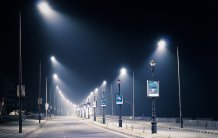
New research suggests a link between the “blue light” emitted by street lights and an increased risk of certain cancers
“Blue light” of LED streetlights linked to breast and prostate cancer
The “blue light” emitted by street lights including LEDs, and commercial outdoor lighting such as advertising, is linked to a significant increase in the risk of breast and prostate cancer, innovative new research has concluded.
A study led by the Barcelona Institute for Global Health (ISGlobal) and involving the University of Exeter found that participants living in large cities with heavy exposure to blue lights at night had double the risk of prostate cancer and 1.5 times higher risk of breast cancer. This was compared to populations with less exposure to blue light.
Older lighting schemes emit a glow within the “orange” spectrum, but new modern lighting creates a bright “blue” light emission. The researchers found the bluer the light emission that people in large cities were exposed to, the higher the risk of cancer. The study also found that people who lived in homes with darker rooms, by using window shutters for example, had lower risk than those who did not.
The study, published in Environmental Health Perspectives includes medical and epidemiological data of more than 4,000 people between 20 and 85 years of age in 11 Spanish regions. It particularly examined Madrid and Barcelona. Indoor exposure to artificial light was determined through personal questionnaires. In the first study of its kind, outdoor levels of artificial light were evaluated based on night-time images taken by astronauts aboard the International Space Station.
Dr Alejandro Sánchez de Miguel, of the University of Exeter, said: “Humans have evolved to need light during the day and darkness at night. As towns and cities replace older lighting, we’re all exposed to higher levels of “blue” lights, which can disrupt our biological clocks. It’s imperative that we know for sure whether this increases our risk of cancer. Scientists have long suspected this may be the case – now our innovative findings indicate a strong link. We must also investigate whether night-time exposure to the blue light emitted by smartphones and tablets increases our risk of cancer. We must now improve our research methods to ensure this is robust so we can advise on how best to protect human health. Currently, the images taken by astronauts on the International Space Station are our only way of determining the spread of blue light-emitting white LEDs in our cities.”
Little is known about how environmental factors affect breast and prostate cancer. The researchers hypothesise that LED lights may disrupt the body’s 24-hour cycle known as the circadian rhythm, in turn affecting hormones. Both breast and prostate cancer are hormone-related.
Previous research has shown an increased risk between prostate cancer and night shift work. It is also known that artificial light, particularly in the blue spectrum, can decrease the body’s production and secretion of the hormone melatonin. Melatonin plays a key role in regulating the day-night cycles and has several other key functions, for example it is a powerful anti-oxidant and has also an anti-inflammatory function. However, its role in breast and prostate cancer is not yet understood.
Manolis Kogevinas, ISGlobal researcher and coordinator of the study, said: “The World Health Organisation’s International Agency for Research on Cancer (IARC) has classified night shift work as probably carcinogenic to humans. There is evidence pointing to an association between exposure to artificial light at night, disruption of the circadian rhythm, and breast and prostate cancers.
“With this study we sought to determine whether night exposure to light in cities can affect the development of these two types of cancer.”
Martin Aubé, physics professor at CÉGEP in Sherbrooke, Canada and study co-author, said: “We know that depending on its intensity and wave length, artificial light, particularly in the blue spectrum, can decrease melatonin production and secretion.”
The study was conducted within the framework of the MCC-Spain project cofunded by the ‘Consorcio de Investigación Biomédica en Red de Epidemiología y Salud Pública’ (CIBERESP).
Ariadna García, ISGlobal researcher and first author of the study, says: “Given the ubiquity of artificial light at night, determining whether or not it increases the risk of cancer is a public health issue.
“At this point, further studies should include more individual data using for instance light sensors that allow measuring indoor light levels. It would also be important to do this kind of research in young people that extensively use blue light emitting screens.”
The full paper, ‘Evaluating the association between artificial light-at-night exposure and breast and prostate cancer risk in Spain (MCC-Spain study)’, is published in the journal Environmental Health Perspectives. Authors are Garcia-Saenz A., Sánchez de Miguel A., Espinosa A., Valentín A., Aragonés N., Llorca, J., Amiano P., Martín Sánchez V., Guevara M., Capelo R., Tardón A., Peiró-Pérez R., Jiménez-Moleón JJ., Roca-Barceló A., Pérez-Gómez B., Dierssen-Sotos T., Fernández-Villa T., Moreno-Iribas C., Moreno V., García-Pérez J., Castaño-Vinyals G., Pollán M., Aubé M., Kogevinas M.
Date: 26 April 2018
